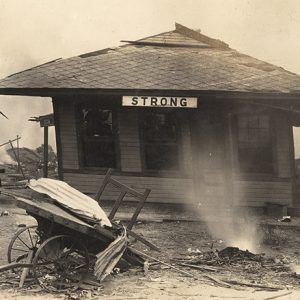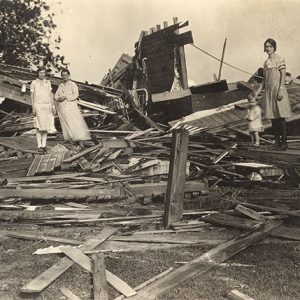calsfoundation@cals.org
Strong (Union County)
| Latitude and Longitude: | 33º06’27″N 092º20’06″W |
| Elevation: | 98 feet |
| Area: | 1.60 square miles (2020 Census) |
| Population: | 410 (2020 Census) |
| Incorporation Date: | September 7, 1903 |
Historical Population as per the U.S. Census:
|
1810 |
1820 |
1830 |
1840 |
1850 |
1860 |
1870 |
1880 |
1890 |
1900 |
|
– |
– |
– |
– |
– |
– |
– |
– |
– |
– |
|
1910 |
1920 |
1930 |
1940 |
1950 |
1960 |
1970 |
1980 |
1990 |
2000 |
|
465 |
507 |
740 |
762 |
839 |
741 |
965 |
785 |
624 |
651 |
|
2010 |
2020 |
|
|
|
|
|
|
|
|
|
558 |
410 |
|
|
|
|
|
|
|
|
Strong, located seven miles north of the Louisiana border, was founded in the early twentieth century as a settlement along the railroad tracks. Originally named Victoria, the settlement grew quickly. Later rechristened as Strong, it became an important shipping station for local farm products, especially cotton.
Union County experienced significant growth with railroad construction through the area in the late 1800s. One such railroad, the El Dorado and Bastrop Railway, was built in the early 1900s. Once the railroad was completed, management posted notices calling leaders of the surrounding small southern Union County communities to a meeting to discuss area development. During the poorly attended meeting, held in Collinston, Louisiana, James Solomon Coleman offered a right-of-way to his land at present-day Strong for development. Railroad executives dispatched William Strong, who accepted the property after examination. Strong named the soon-to-be-constructed rail stop Victoria.
Coleman had a 120-acre plot surveyed and began to sell lots in 1902. Henry Clay, who became the community’s first law enforcement officer, and his family became the first settlers. With Ernest J. Dugal as the first depot agent, Victoria began to grow. On April 10, 1903, the post office at nearby Concord (Union County) was relocated to the new community, with Stephen McBride as postmaster. By 1903, the Gorman brothers opened the first mercantile store, and the Victoria Bank also opened. The community was incorporated as a second-class city on September 7, 1903.
As the city began to grow and develop, confusion over the name arose. Apparently sometime after its incorporation as Victoria, Coleman named the train stop Strong in honor of railroad employee William Strong. When the Concord post office was relocated to Victoria, it was discovered that a post office of that name already existed. On August 9, 1904, the post office was re-chartered as Strong with William Ward as postmaster. Even into the 1940s, however, many local citizens continued to refer to it as Victoria.
The growing city became an important supply source for local lumber operations and a shipping point for area cotton farmers. Soon, a city government was organized with H. A. Nelson as the first mayor. In 1903, Baptists were holding services in a local store building. By 1906, the several businesses included an ice house and bottle works. Electricity became available in 1914 when Arch Herring built a generating plant. Power was provided daily on a limited basis. A number of local men served in World War I, with many of the women assisting the Red Cross in providing clothing for the troops. These women met regularly in a room over a local business to knit clothing and roll bandages. By 1920, the city’s population had exceeded 500.
During the 1920s, Strong began to experience a steady growth that lasted until the 1960s. This growth was in part prompted by the opening of the Strong Lumber Company, which employed many locals. Among the city businesses were three sawmills, three cotton gins, two grist mills, three motion picture houses, three hotels, two livery stables, two drugstores, four general stores, and two barbers. Eight passenger trains a day stopped in the city.
In 1919, James Victor Spencer, an important area developer, purchased the electric generating plant. Spencer also sponsored and coached the Strong Light Plant, a popular baseball team that supposedly sent five players to the major leagues in the 1920s. In the mid-1920s, the city granted Arkansas Power and Light (AP&L) the right to supply power to about 150 customers. By 1950, the company had built an office in the city.
On May 9, 1927, a tornado hit the city. In the afternoon, the storm entered the southwestern tip of the city, passing through the main business district. Before leaving the town, the twister destroyed an area approximately three blocks wide and one and a half mile long. Thirty people were killed and an estimated 100 or more injured. The Red Cross operated an aid station to provide assistance. Some of the dead were buried in combined funerals, with as many as fifteen being buried at one time.
The city quickly recovered from the deadly storm, with much of the business district being replaced by new brick structures. Included in the new construction were a large warehouse, two electric cotton gins, and a sixteen-room schoolhouse with an auditorium.
By the 1930s, perhaps due to its close proximity to sawmill camps, the city had begun to develop a reputation as a rough place. It was reported to be home to several houses of prostitution. During Prohibition, alcohol was supplied by local moonshiners, but after repeal, the city had as many as eight alcohol-serving establishments, including one called the Bloody Bucket. Fights were said to be common, and a few deaths were reported.
The Citizens Bank of Strong was founded on January 21, 1931, but the farming and lumber city was hit hard by the Great Depression. During the 1930s, the local school was consolidated with several of the smaller area districts. The Concord school building was removed to Strong. Even during hard times, the city population increased, reaching 762 by the end of the decade.
Recovery from the Depression was slow. Several local men served in the armed forces during World War II. Following the end of the war, there was a concerted effort by city leaders to promote prosperity and growth. In 1949, the city joined the Community Development Program. Under the program, several areas were targeted for city improvement. The first project was a citywide clean-up program. For several weeks, the business district closed each Wednesday, and citizens went around town cleaning and repairing. School enhancement included the construction of a new modern gym, the first constructed outside the county seat. Streets were graveled, the city park was renovated, a municipal water system was added, a medical clinic opened, and a volunteer fire department was established. By the end of the decade, the city’s population had increased by more than seventy residents.
Growth continued during the post–World War II years, but by the late 1950s, population had decreased. After a period of growth in the 1970s, the city’s population began a general decline. Twenty-first-century Strong is a thriving community with more than sixty officially recognized businesses and organizations. In the early twenty-first century, the school system was consolidated with the nearby Huttig District. Students in grades K–12 attend classes in the Strong-Huttig School District, consisting of Strong-Huttig High School and Gardner-Strong Elementary School, both located in Strong.
For additional information:
Bishop, Vickie. “Tornadoes Strike Union County May 9, 1923.” Tracks and Traces 10 (May 1988): 1–12.
Burson, Michael K. The Town with Two Names: Victoria/Strong, Arkansas: A New History. Delight, AR: Alexander Printing Company, 2012.
Cordell, Anna Harmon. Dates and Data of Union County, Arkansas, 1541–1948. Monroe, LA: Century Printing and Publishing, Inc., 1984.
Knox, Merle. History of Strong, Arkansas 75 Years. Camden, AR: The Hurley Co., 1979.
Mike Polston
CALS Encyclopedia of Arkansas
 Strong Tornado
Strong Tornado  Strong Tornado Damage
Strong Tornado Damage  Union County Map
Union County Map 



My daddy operated the Standard Oil Relay Station in Strong for twenty-five years.